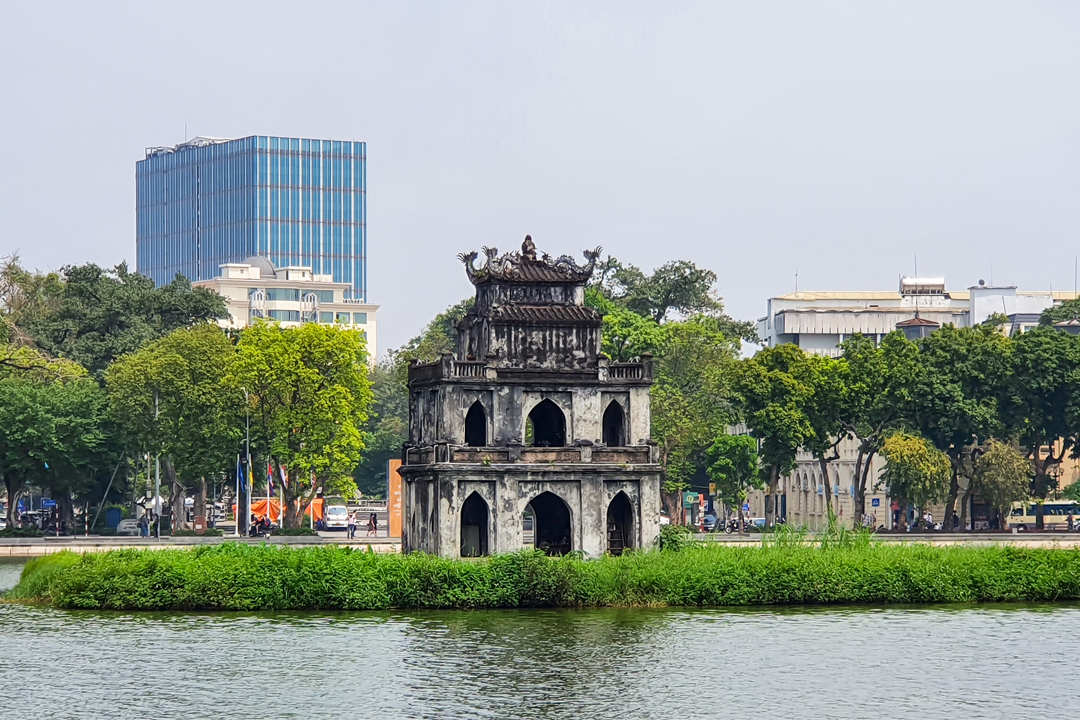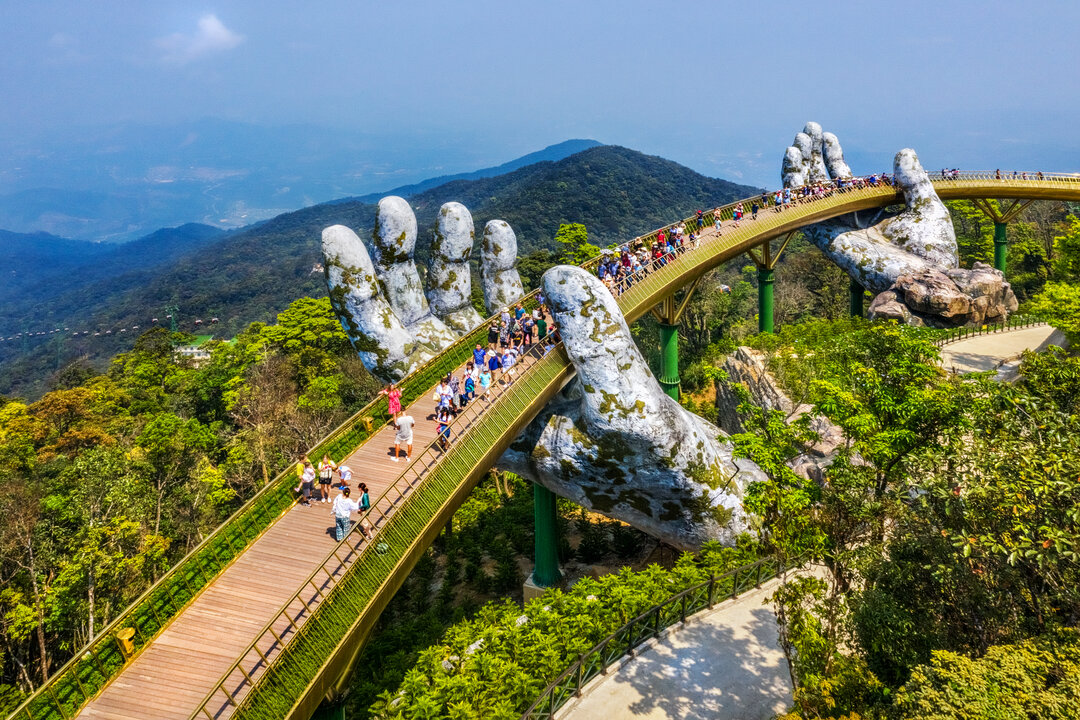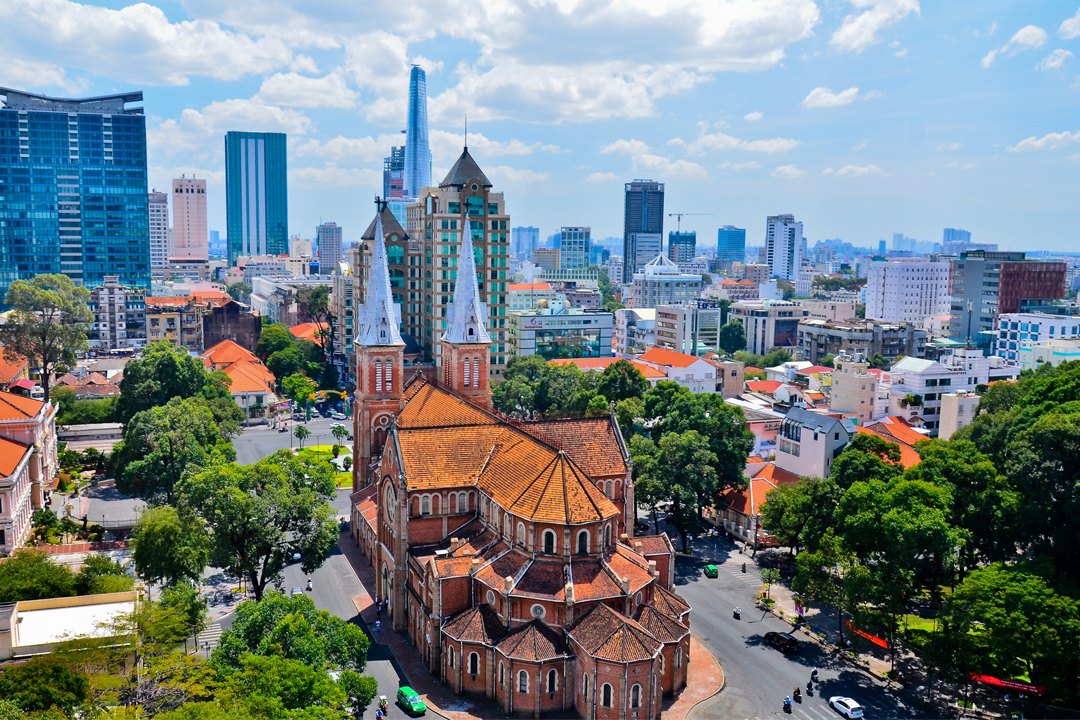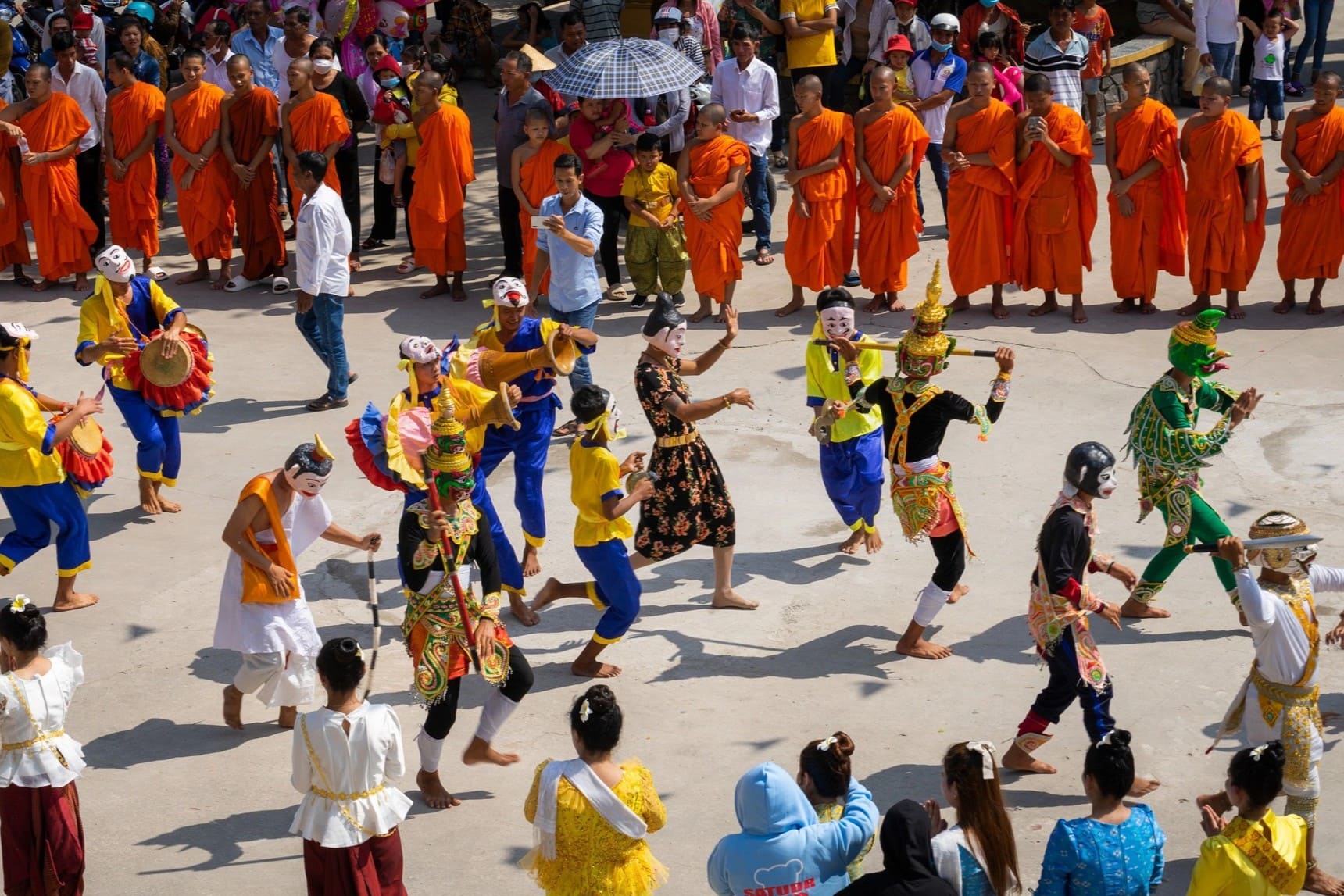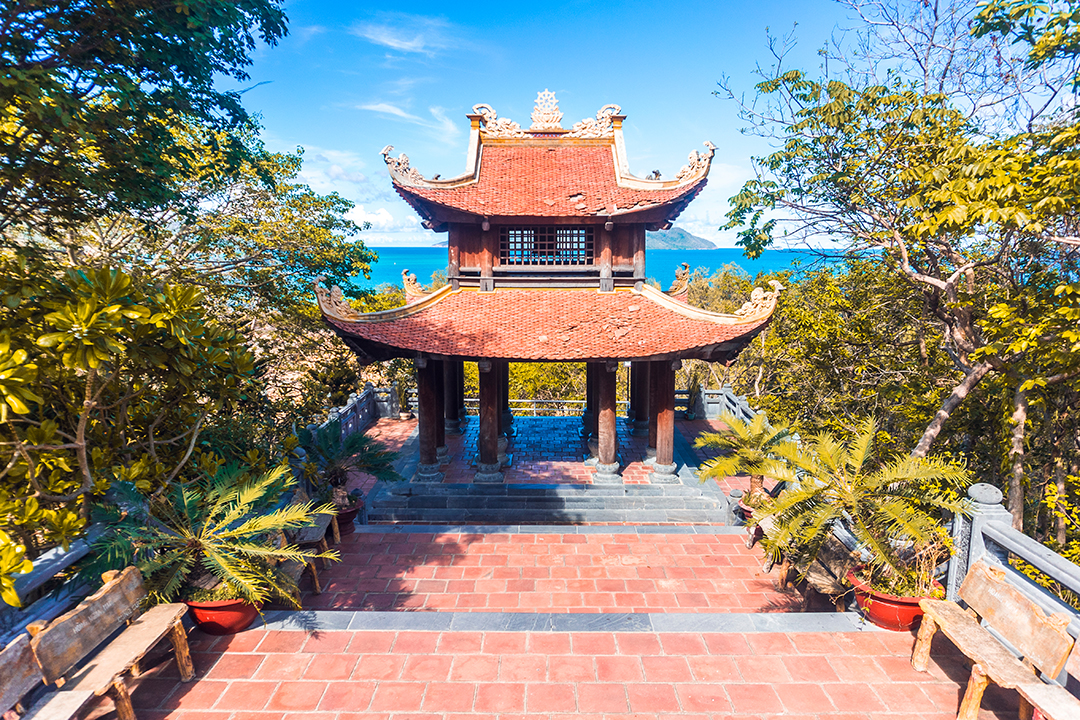Van Son Pagoda: History, Architecture, Things To Do & Travel Guide
Van Son Pagoda (known as Nui Mot Pagoda) is located in halfway up Nui Mot Mountain, about 1.6 km from Con Son town, Con Dao Island, Ba Ria - Vung Tau Province. It stands as one of the most revered spiritual sites in Con Dao, attracting people with its historical significance, intricate architecture, and breathtaking views. This sacred destination is deeply rooted in the island's Buddhist heritage, believed to have served as a retreat for monks for centuries. In this guide, GTrip explores everything you need to know about Van Son Pagoda, from its history to its serene ambiance.
Beyond its rich history, the pagoda captivates with its traditional Vietnamese Buddhist architecture, graceful curved roofs, elaborate carvings, and serene Buddha statues. Besides, understanding the dress code and visitor guidelines ensures a respectful and fulfilling experience. Our guide provides essential travel tips to help you prepare. Additionally, we cover key details like entrance fees, opening hours, and directions, so you can navigate your journey with ease.
Timing your visit is also crucial; discover the best season to visit Van Son Pagoda, ensuring clear weather conditions for sightseeing. And while you're in Con Dao, don't miss out on nearby attractions such as the historic Hang Duong Cemetery, the serene Dat Doc Beach. To make your visit seamless, this guide also answers common questions travelers have. Let’s prepare for an enriching experience at one of Con Dao’s most significant landmarks!
History of Van Son Pagoda
Van Son Pagoda has profound historical and spiritual significance, closely linked to the development of Buddhism in Con Dao. The pagoda, also known as Mot Mountain Pagoda, was originally built by the US puppet regime in 1964 during the Vietnam War. Its main purpose was to serve as a religious and cultural site for soldiers and government officials stationed on Con Dao Island at that time. In addition, the pagoda was also intended to deceive the people, the press, and world public opinion about their violent domination of prisoners.
In 1965, to save costs and manpower, the former Saigon government forced prisoners detained in Phu Hai Prison to carry materials to build the pagoda from the foot of the mountain to the top. The work was extremely tough and arduous, leading to the deaths of 63 prisoners from illness and exhaustion. The deceased prisoners were later buried in Hang Duong Cemetery.
In 1975, when Vietnam was liberated, the pagoda became a place to worship Buddha, a place for islanders to immerse themselves in spiritual religion. Over the years, the pagoda has undergone significant restoration and expansion, thanks to the generosity of benefactors and islanders. Van Son Pagoda was completely restored in December 2011. Today, Van Son Pagoda is a symbol of resilience and devotion, attracting both pilgrims and tourists who want to learn about the spiritual heritage of Con Dao.
As one of the most important Buddhist sites in the region, Van Son Pagoda is also closely associated with the natural beauty of Con Dao National Park. Many people to the pagoda take the opportunity to explore the lush landscape of Con Dao National Park, reinforcing the connection between the retreat and nature.
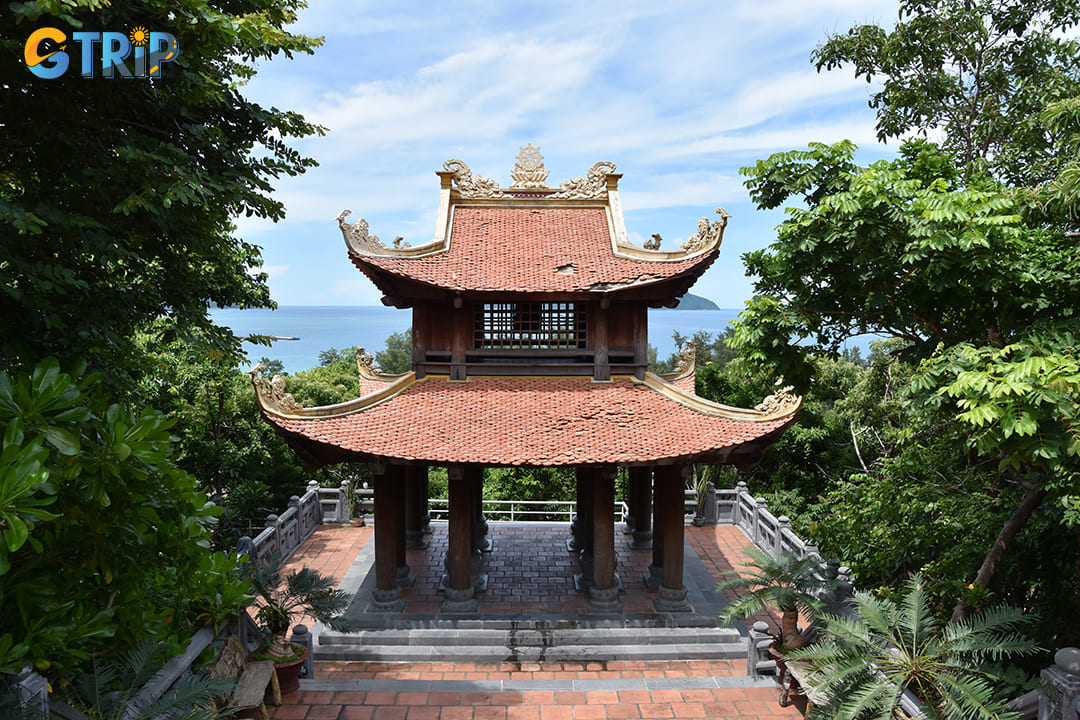
Van Son Pagoda has profound historical and spiritual significance, closely linked to the development of Buddhism in Con Dao
Architecture of Van Son Pagoda
Van Son Pagoda architecture reflects the essence of traditional Vietnamese Buddhist design, harmonizing spiritual symbolism with nature. The pagoda is situated on a prime location, leaning against the verdant slopes of Mot Mountain and facing Con Son Bay and An Hai Lotus Lake, creating a tranquil setting.
Covering an expansive area of approximately 19,434 m², the pagoda complex is meticulously structured, featuring key religious and architectural elements:
- The Welcome Gate: Designed in the classic Tam Quan (three-entrance) style, symbolizing the Buddhist concept of escaping worldly desires to reach enlightenment.
- The Ancestor’s Temple: A sacred hall dedicated to venerating past Buddhist monks and figures who contributed to the development of Buddhism in Con Dao.
- Dia Tang Temple: Honoring Kṣitigarbha Bodhisattva, known in Vietnamese culture for his vow to guide lost souls and protect the deceased.
- The Bell Tower: Housing a large bronze bell, which resonates through the mountains, calling for peace and mindfulness.
- Quan Am Buddha Statue: A prominent highlight of the complex, the statue of Bodhisattva Guanyin, standing over 2 meters high on a lotus pedestal, is a symbol of compassion. The figure holds a vase of nectar, signifying her role in alleviating suffering.
- Son Than Temple: A shrine dedicated to the mountain deities, believed to protect Van Son Pagoda and bless people.
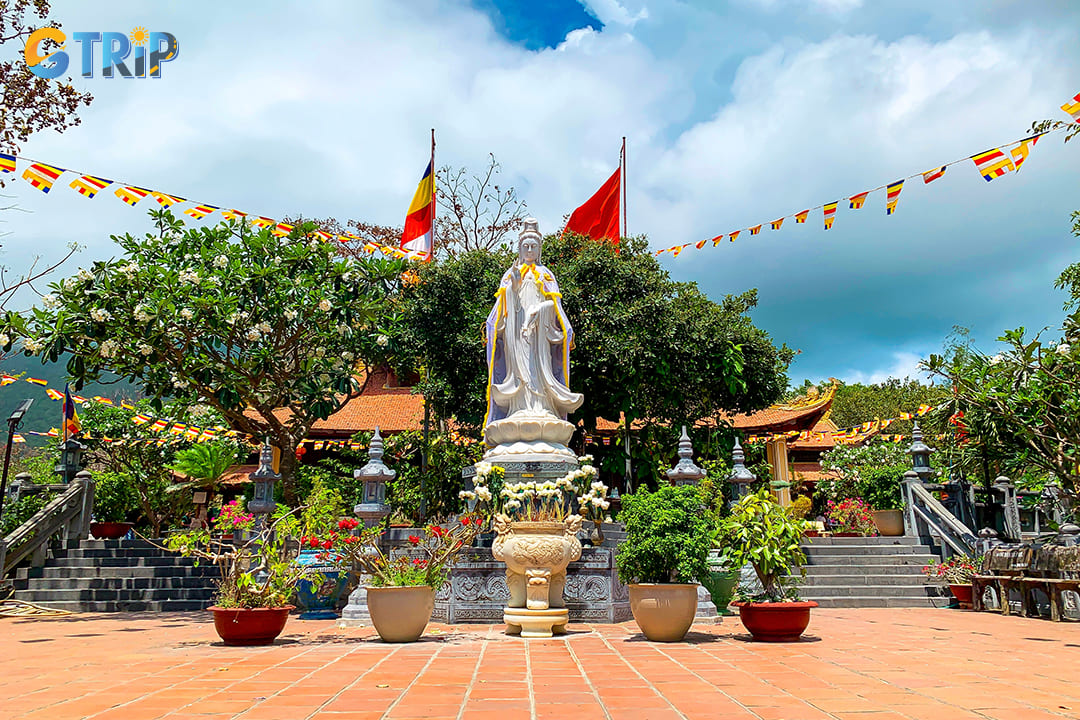
A prominent highlight of the complex, the statue of Quan Am Buddha, standing over 2 meters high on a lotus pedestal, is a symbol of compassion
The architectural details are deeply rooted in Vietnamese craftsmanship, featuring gracefully curved roofs with intricate carvings of dragons and phoenixes, representing protection and enlightenment. The wooden pillars and beams showcase exquisite traditional motifs, while statues of Buddha and other deities are meticulously sculpted, embodying both artistic beauty and spiritual devotion.
Reaching Van Son Pagoda requires climbing more than 200 stone steps, a journey that enhances the spiritual experience as you ascend through the lush forest. The ascent offers breathtaking views of Con Dao’s pristine landscapes, reminiscent of the serene scenery found in Bay Canh Island, another significant natural and historical site in the region.
The harmonious blend of architecture, natural surroundings, and spiritual significance makes Van Son Pagoda a place of worship and a site for reflection and appreciation of Vietnamese Buddhist heritage. This architectural grandeur complements the overall spiritual experience, setting the stage for those who seek tranquility and self-discovery.
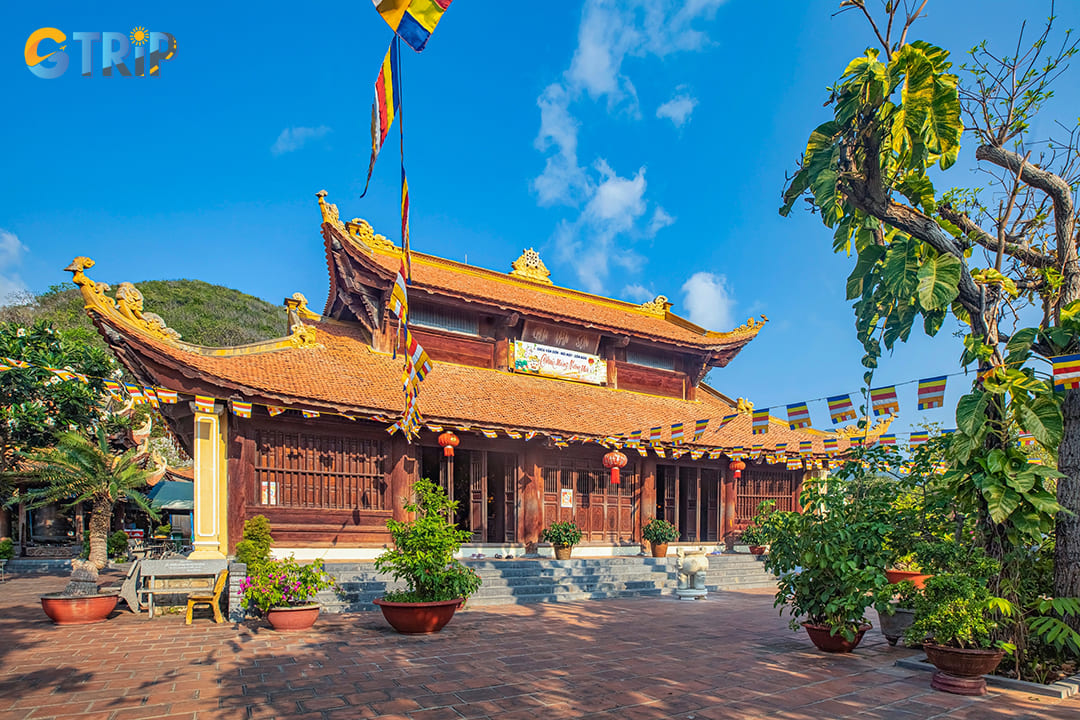
The architectural details are deeply rooted in Vietnamese craftsmanship, featuring gracefully curved roofs with intricate carvings of dragons and phoenixes
3 things to do at Van Son Pagoda
Van Son Pagoda offers tourists a unique blend of spirituality, nature, and breathtaking landscapes. Perched atop Mot Mountain, the pagoda is an ideal destination for those seeking tranquility, cultural exploration, and scenic beauty. Below are the top activities tourists can enjoy at this sacred site.
1. Meditate in a peaceful spiritual setting
Van Son Pagoda provides a serene environment that is perfect for meditation and self-reflection. The temple's elevated position, surrounded by lush greenery and overlooking the vast Con Son Bay, allows people to escape the noise of daily life and immerse themselves in a state of inner peace. A key highlight is the Quan Am Buddha Statue, standing over two meters high on a lotus pedestal, which serves as an inspiring focal point for those seeking mindfulness and enlightenment. The soft ringing of temple bells, combined with the rhythmic sound of waves in the distance, creates a calming atmosphere that enhances the meditation experience. Many people choose to sit quietly in designated areas, focusing on their breath while embracing the spiritual energy of their surroundings.
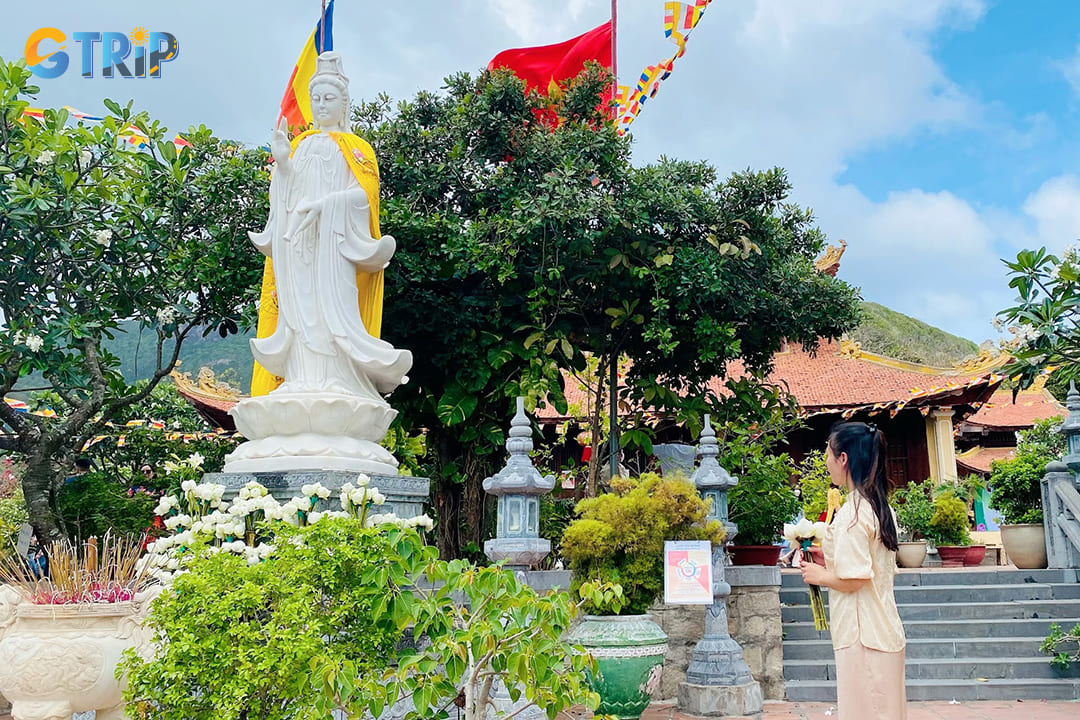
Van Son Pagoda provides a serene environment that is perfect for meditation and self-reflection
2. Capture stunning panoramic views
One of the biggest draws of Van Son Pagoda is its unparalleled panoramic views. The pagoda is strategically built on an elevated position, offering people a breathtaking vantage point of Con Son Bay and the surrounding islands. From the temple grounds, travelers can marvel at the turquoise waters stretching endlessly into the horizon, creating a scene of pure tranquility. On clear days, it is even possible to spot Bay Canh Island, a well-preserved ecological reserve that serves as an important nesting ground for sea turtles. Photographers and nature lovers often visit the pagoda during sunrise and sunset, when the sky is painted with vibrant hues of orange, pink, and purple, enhancing the temple’s mystical beauty.
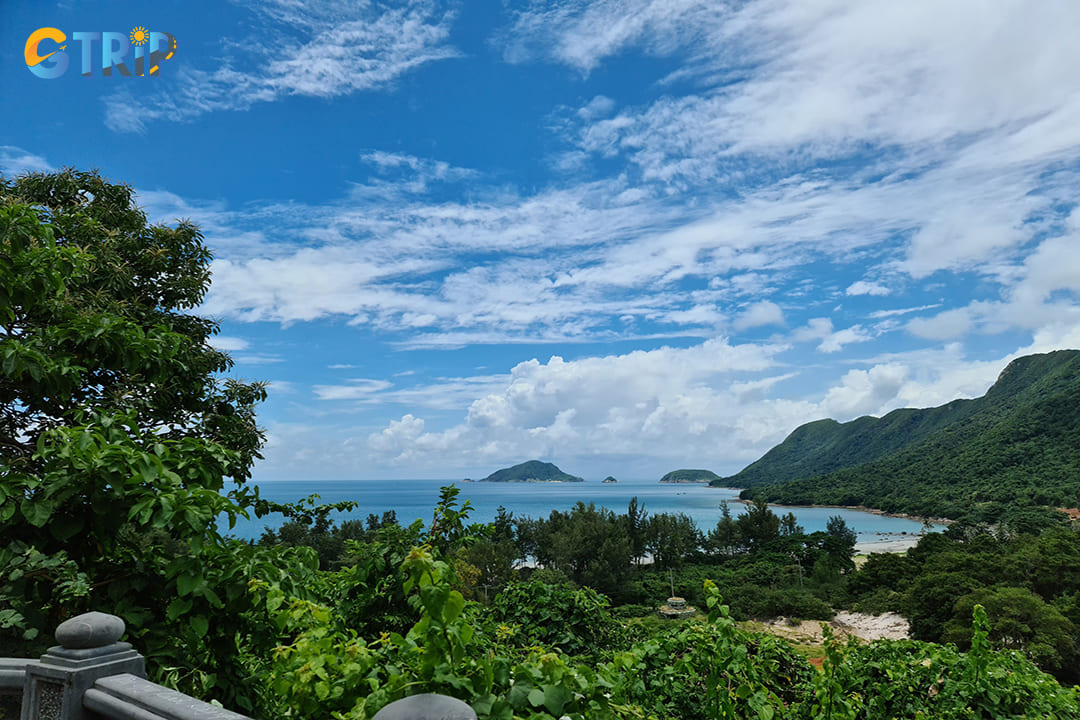
One of the biggest draws of Van Son Pagoda is its unparalleled panoramic views
3. Experience a Buddhist ceremony
For those interested in Vietnamese Buddhist culture, Van Son Pagoda offers a great opportunity to observe and participate in local religious ceremonies. Worshippers and tourists alike can participate in traditional ceremonies, where incense, flowers, and fruits are placed before statues to ask for blessings and express gratitude. Normally, people go to pagodas to pray for peace, money, fortune, and fame. Buddha's compassion helps people have the opportunity to repent, pray for the opportunity to correct and do good deeds, but there are no material things or money to give to anyone.
The resident monks at the pagoda perform daily chanting rituals, filling the air with sacred mantras that create a deeply spiritual atmosphere. These rituals provide insight into the Buddhist way of life and provide a moment of reflection for people, regardless of their religion. These events attract both locals and tourists, making them a great time to witness authentic Vietnamese religious traditions.
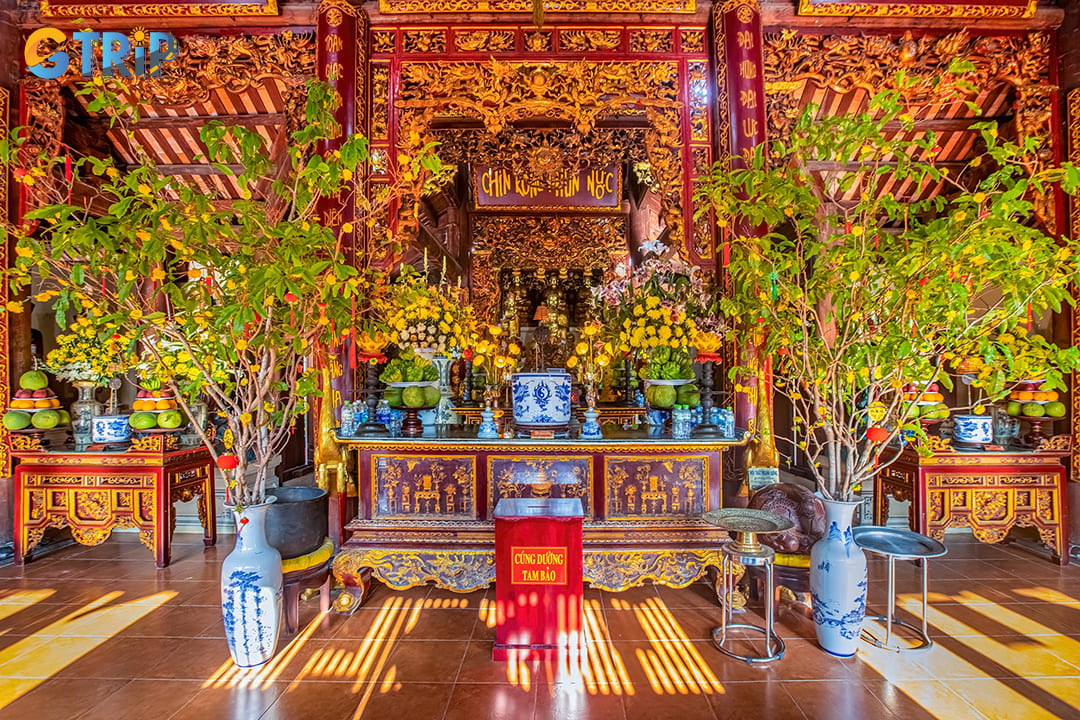
Van Son Pagoda offers a great opportunity to observe and participate in local religious ceremonies
With so much to offer, Van Son Pagoda is a religious site and also a place where people can meditate, explore nature, admire landscapes, and experience rich cultural traditions. Before visiting, you should respect temple etiquette, including wearing modest clothing and maintaining a calm demeanor, to ensure a meaningful and fulfilling experience.
Van Son Pagoda entrance fee and opening hours
Van Son Pagoda is open daily, allowing tourists to explore its spiritual and architectural beauty at any time during regular hours. The temple does not charge a mandatory entrance fee, making it accessible to all who seek a moment of peace and reflection. However, you are encouraged to make voluntary donations, which contribute to the upkeep of the pagoda, support daily religious activities, and preserve its historical significance.
The pagoda generally welcomes guests from early morning until late afternoon, from 6:00 AM and 6:00 PM. Early morning visits offer a serene ambiance, perfect for meditation and quiet contemplation, while late afternoons provide a breathtaking view of the setting sun over Con Son Bay.
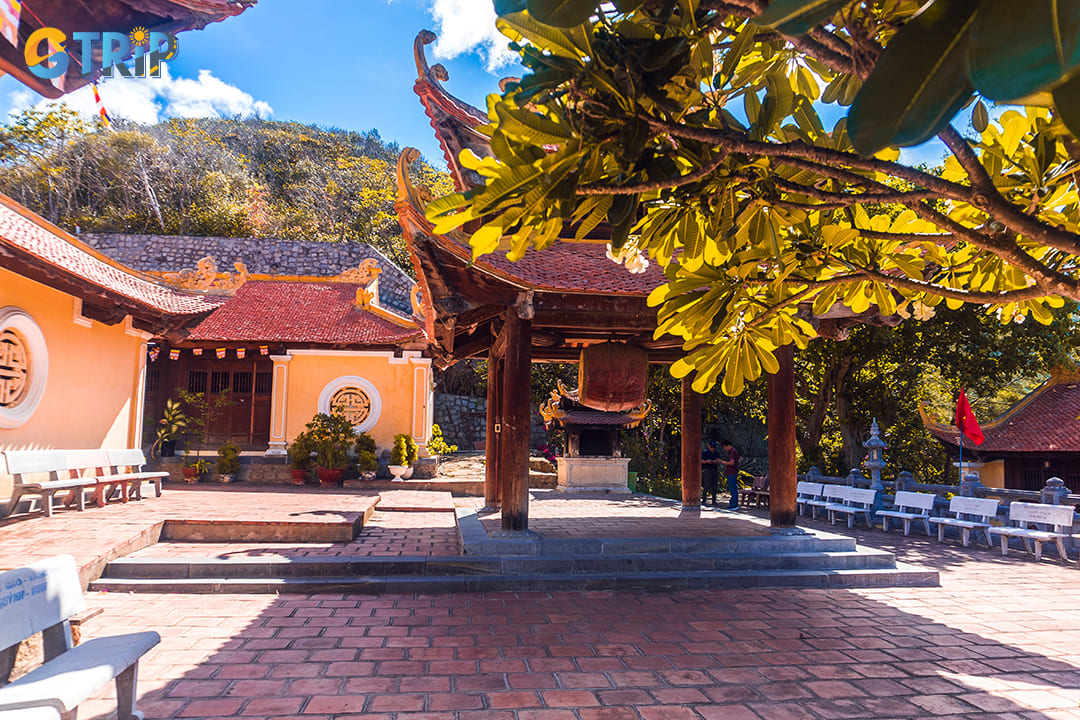
Van Son Pagoda is open daily, allowing tourists to explore its spiritual and architectural beauty at any time during regular hours
Best time to visit Van Son Pagoda
The best season for visiting Van Son Pagoda is during the dry months, typically from November to April. This period offers clear skies, pleasant temperatures, and minimal rainfall, creating ideal conditions for sightseeing, photography, and spiritual activities. The absence of heavy rains ensures that the Van Son Pagoda hiking trail remains accessible and safe, allowing you to comfortably navigate the 200-step ascent leading to the temple.
During January and February, Van Son Pagoda becomes particularly vibrant as it coincides with the Vietnamese Lunar New Year (Tet) and other Buddhist festivals. Pilgrims and tourists gather to offer prayers, witness traditional ceremonies, and experience the pagoda’s spiritual ambiance. While this is a culturally enriching time to visit, the increased number of tourists may result in crowded conditions.
For those who prefer a quieter atmosphere, March and April are excellent months. The weather remains favorable, and the crowds thin out after Tet, allowing people to immerse themselves in the tranquility of the pagoda. The panoramic view from the temple is especially breathtaking in the early mornings as the sunlight reflects off Con Son Bay, creating a serene and picturesque scene.
Avoid visiting during the rainy season from May to October, as heavy showers and occasional storms can make the steep hiking path slippery and challenging. The humidity levels also rise, which may make outdoor exploration less comfortable. However, if visiting during these months, early morning or late afternoon is the best time to avoid the midday heat.
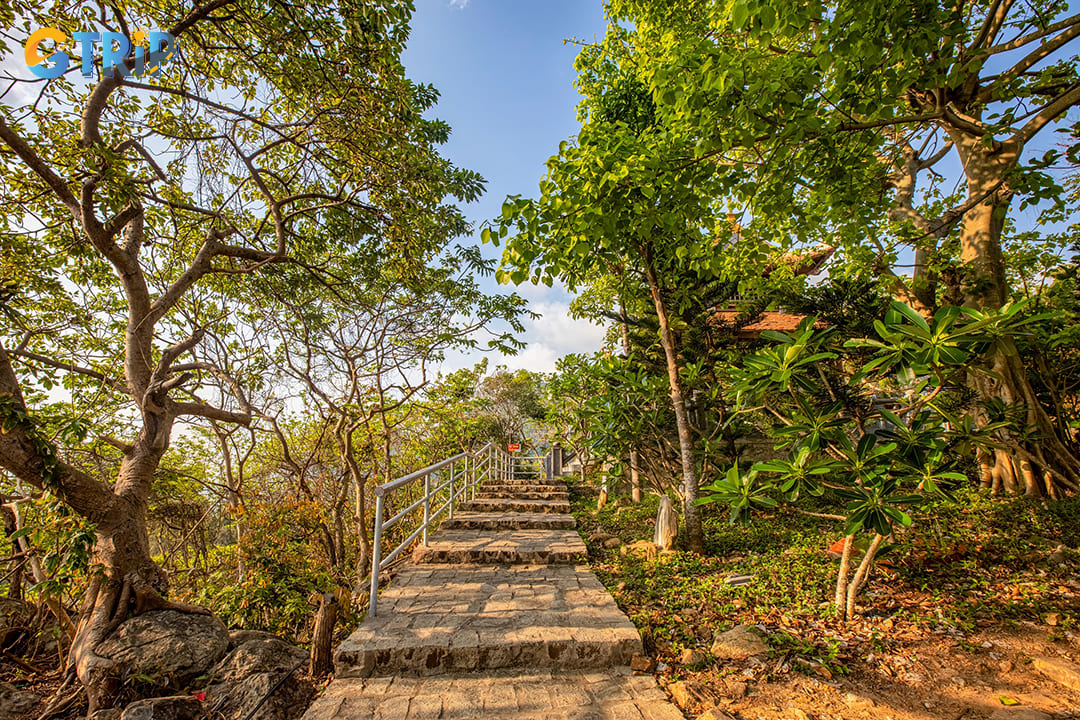
The absence of heavy rains ensures that the Van Son Pagoda hiking trail remains accessible and safe
How to get to Van Son Pagoda?
Before reaching Van Son Pagoda, you must first travel to Con Son Island, as the pagoda is located on Mot Mountain within the island’s main area. Con Son Island is accessible by flight or ferry, with direct flights available from Ho Chi Minh City, Can Tho, and Hanoi. Airfare prices typically range from 1,500,000 - 3,500,000 VND ($60 - $140) depending on the season and departure location.
Alternatively, ferries operate from Vung Tau and Soc Trang, offering a scenic sea route. Ferry tickets cost between 300,000 - 1,200,000 VND ($12 - $50) depending on the class and departure point. The pagoda is located on Mot Mountain, about 1.6 km from Con Son Town, so after arriving at Con Son Island, you can get to Van Son Pagoda by many different means of transport, such as:
By motorbike
Traveling by motorbike is one of the most convenient and flexible ways to reach Van Son Pagoda. You can rent motorbikes from local services in Con Son Town for around 150,000 - 200,000 VND per day ($6 - $8). The journey follows the main road along Tran Phu Street, passing through peaceful villages and offering glimpses of Con Son Bay along the way. The ride takes approximately 10 - 15 minutes to the base of the pagoda. Motorbike parking is available near the entrance, but from this point, you must continue on foot, climbing over 200 stone steps to reach the temple.
By taxi
For those seeking a more comfortable option, taxis are readily available in Con Son Town. The journey by taxi typically takes 10 minutes, costing around 100,000 VND per one-way trip. Taxis can drop passengers at the base of the hill, from where the hiking trail begins. It is recommended to arrange for a return trip in advance, as taxis may not always be available near the pagoda.
Many people combine their taxi ride with stops at other nearby attractions, such as Con Dao Museum, which provides a deeper understanding of the island’s historical significance. Choosing the right transportation method depends on individual preferences and fitness levels. Once you reach Van Son Pagoda, the tranquil atmosphere and scenic views make the journey a rewarding experience.
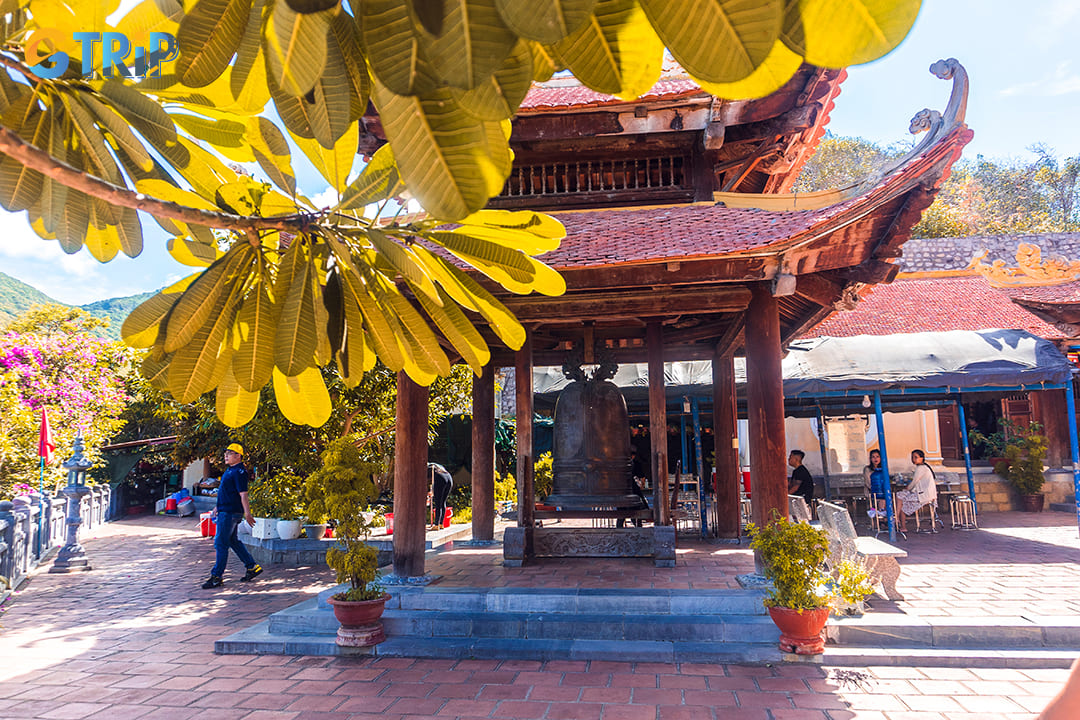
Before reaching Van Son Pagoda, you must first travel to Con Son Island
Dress code and visiting tips
When visiting Van Son Pagoda, it is essential to observe appropriate etiquette and respect the spiritual significance of this sacred site. Adhering to the Van Son Pagoda dress code and following proper customs will ensure a meaningful and harmonious experience.
Appropriate attire when visiting Van Son Pagoda
You should dress modestly to show respect for the religious setting. Clothing should cover the shoulders, chest, and knees, as revealing clothing is considered disrespectful. Recommended attire includes long pants or knee-length skirts, loose-fitting shirts that cover the shoulders, and avoiding sleeveless shirts, shorts, or tight clothing. Shoes should be removed before entering the prayer room and sacred space. Some areas may have designated shoe storage areas.
Rituals and taboos inside the temple
To maintain the sacredness of Van Son Pagoda, you must adhere to specific behavioral guidelines:
- Keep quiet: Conversation volume should be kept low, especially inside worship areas where monks and devotees pray or meditate.
- Avoid pointing at Buddha statues: In Vietnamese Buddhist culture, pointing at sacred objects, especially with the index finger, is considered disrespectful.
- Do not touch religious artifacts: Items such as Buddha statues, ritual objects, and altars must be observed from a respectful distance.
- Use both hands when giving or receiving objects: This is a sign of politeness and respect in Buddhist customs.
- Do not cross your legs towards the altar: When sitting inside the temple, avoid pointing your feet towards the altar or statue. Sitting cross-legged or kneeling is the preferred position, but avoid facing the altar directly.
- In the main hall, you are not allowed to place offerings of meat, votive paper money, or hell money.
- Incense should be burned at the top, outside the temple grounds; avoid burning incense inside the temple.
Always avoid smoking, laughing loudly, and making inappropriate gestures. If you are unsure of the appropriate behavior, observe how locals behave inside the temple for reference.
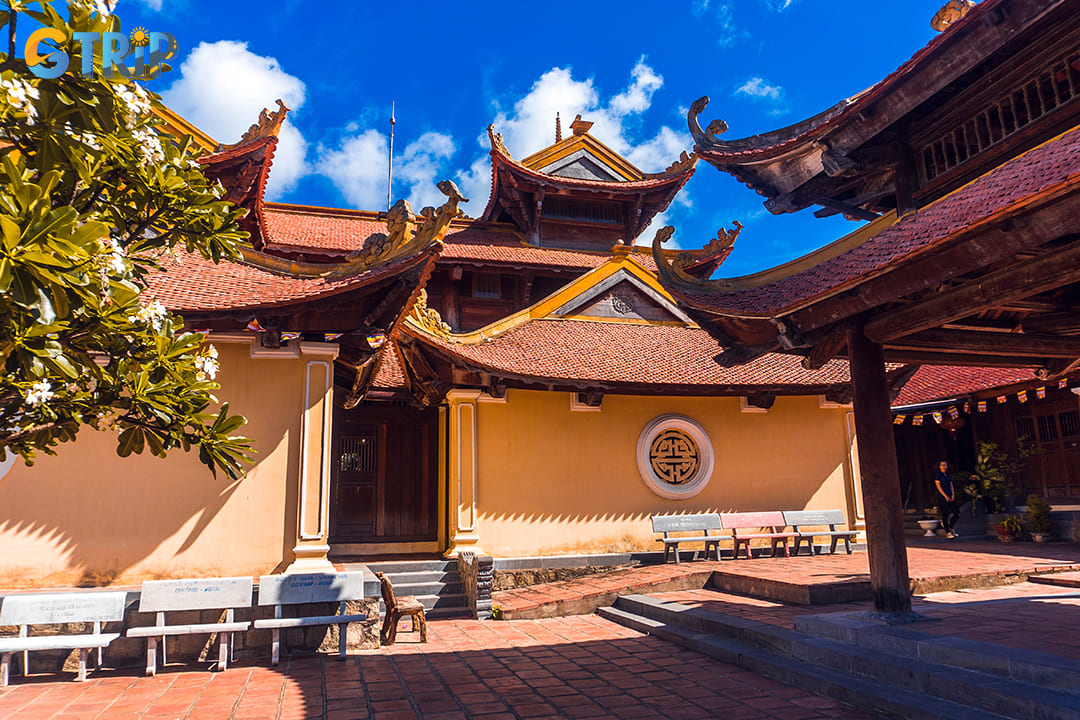
You should dress modestly to show respect for the religious setting
Additional visiting tips
- Best time to visit: Early morning or late afternoon offers a peaceful experience, as these hours are less crowded and the climate is cooler.
- Photography: While photography is permitted in most areas, avoid using flash, especially in the prayer room, to maintain a peaceful atmosphere.
- Respect local traditions: During special ceremonies or religious gatherings, visitors should maintain a respectful distance and avoid disrupting ongoing rituals.
- Prepare useful equipment: Prepare sunscreen, insect repellent, hats, and parasols, as visiting the temple during the day can be quite hot.
Following these guidelines for tourists to Van Son Pagoda will ensure you have a respectful and rewarding experience at this spiritual site.
Nearby attractions to Van Son Pagoda
Exploring the nearby attractions of Van Son Pagoda offers you a diverse experience that combines history, nature, and relaxation. Con Dao is home to significant landmarks, pristine beaches, and untouched islands that enrich any trip to this spiritual site.
Con Dao Museum
Con Dao Museum is an essential stop for those who want to understand the island’s past. The museum is housed in a large, well-preserved colonial-era building and contains over 2,000 artifacts, documents, and photographs that narrate the island’s history. You can explore exhibits detailing Con Dao’s transformation from a penal colony during the French and American periods to a modern-day tourist and conservation hub.
One of the museum’s most striking displays is the section dedicated to the experiences of political prisoners who were held on the island. The exhibit includes personal belongings, letters, and accounts of resistance efforts. Life-sized models and reconstructed prison cells provide a chilling insight into the hardships endured by prisoners. Another highlight is the ecological section, where you learn about the marine and forest conservation efforts that have helped preserve Con Dao’s unique biodiversity.
The museum also features exhibits about the island’s spiritual and cultural aspects, including the revered Vo Thi Sau. She is a national heroine who was executed in Con Dao for her role in the resistance against French colonial rule. You can spend about an hour exploring the museum, making it a meaningful stop before visiting the actual historical sites scattered across the island.
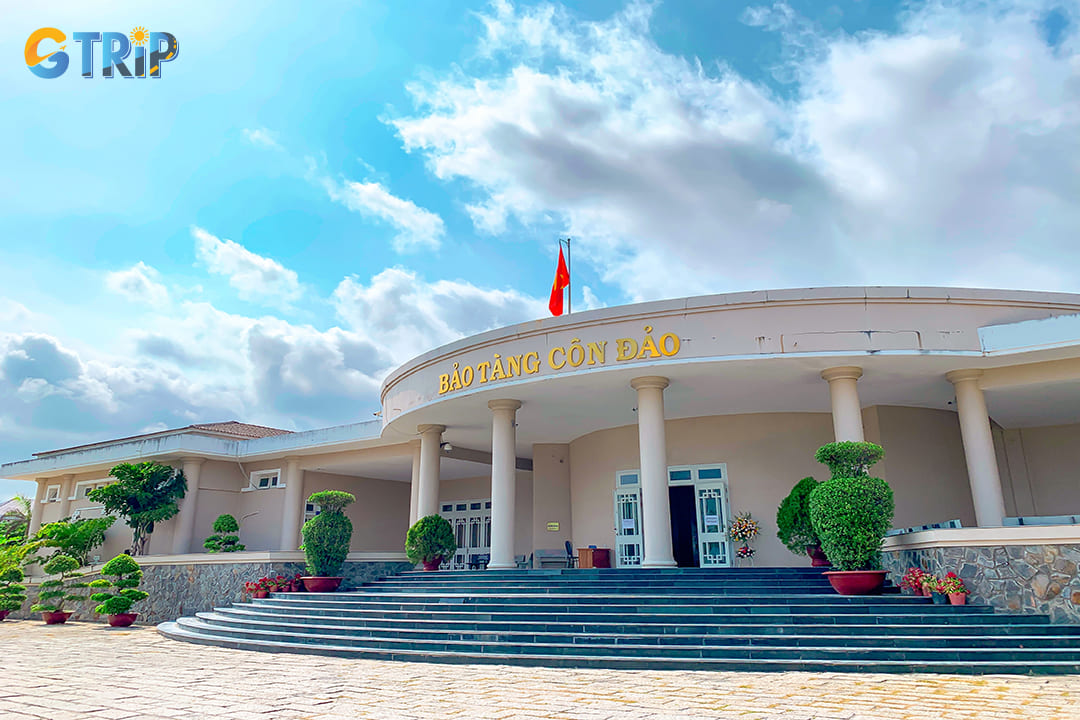
Con Dao Museum is an essential stop for those who want to understand the island’s past
Bay Canh Island
Bay Canh Island is the second-largest island in the Con Dao archipelago and is renowned for its natural beauty, diverse marine life, and environmental conservation programs. The island is heavily forested, with dense tropical vegetation covering its hills, providing a haven for wildlife, including rare birds and reptiles.
One of the most significant aspects of Bay Canh Island is its role in sea turtle conservation. Between May and October, hundreds of green sea turtles come ashore to lay their eggs on the island’s protected beaches. Conservation programs allow you to witness the hatching process and the release of baby turtles into the ocean, a truly memorable and educational experience.
Beyond wildlife, the island offers excellent opportunities for snorkeling and scuba diving. Its coral reefs are home to an array of marine species, from colorful fish to larger creatures like rays and reef sharks. The waters surrounding the island are remarkably clear, making it one of the best spots in Con Dao for underwater exploration.
For adventure seekers, Bay Canh Island features hiking trails that wind through its thick forest, leading to viewpoints that offer stunning panoramas of the surrounding sea. A guided tour of the island often includes stops at hidden beaches, allowing you to experience the unspoiled beauty of Con Dao’s lesser-known spots.
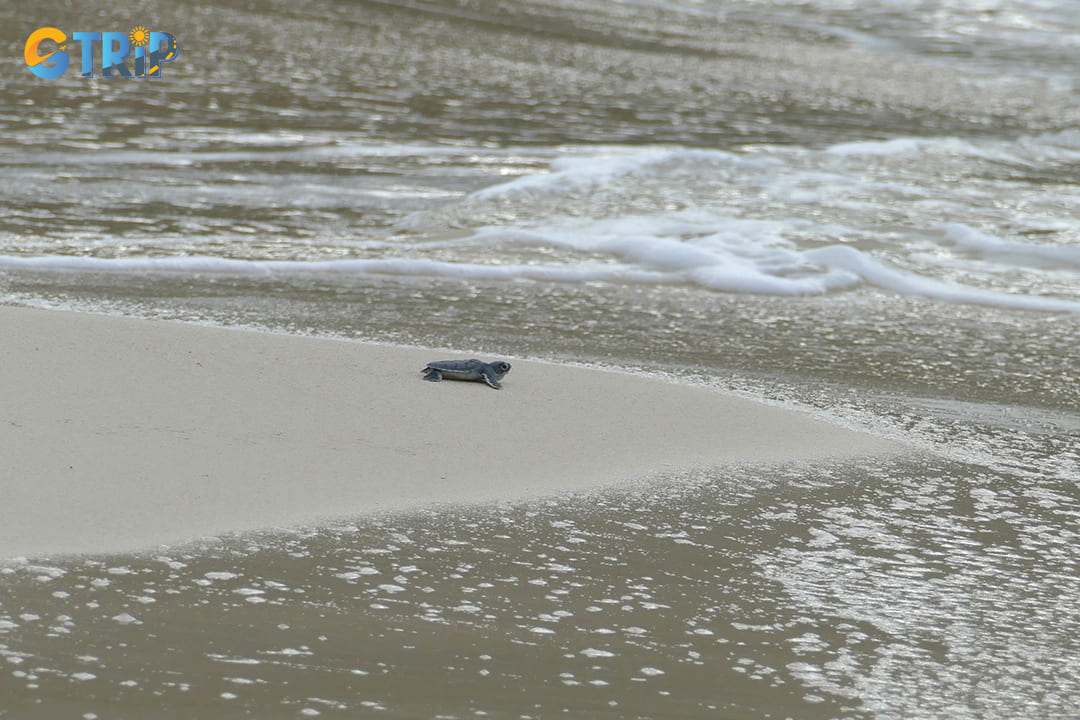
One of the most significant aspects of Bay Canh Island is its role in sea turtle conservation
Dam Trau Beach
Dam Trau Beach is widely regarded as the most picturesque beach in Con Dao, offering a mix of golden sands, clear turquoise waters, and a laid-back atmosphere. It is located near Co Ong Airport, and one of its unique attractions is the experience of watching airplanes fly low over the shoreline before landing.
The beach is surrounded by lush green hills and features rocky formations that add to its natural charm. One of these formations, located at the southern end of the beach, resembles a pair of embracing lovers and has inspired local legends. The calm and shallow waters make Dam Trau Beach an ideal spot for swimming, even for families with children.
Several rustic beachfront restaurants and bars operate along the shore, offering freshly grilled seafood, tropical fruit juices, and refreshing coconut water. You can relax under the shade of palm trees while enjoying delicious local dishes such as grilled squid, steamed fish, and shrimp with tamarind sauce.
For those seeking adventure, Dam Trau Beach has excellent snorkeling spots near its rocky outcrops, where vibrant coral formations and marine life thrive. Additionally, a short walk through a forested path leads to a more secluded beach known as Bai Bien Co, where you can enjoy complete tranquility away from the main crowds. The beach is best visited in the early morning or late afternoon when the sun casts a golden glow over the landscape, creating a breathtaking scene.
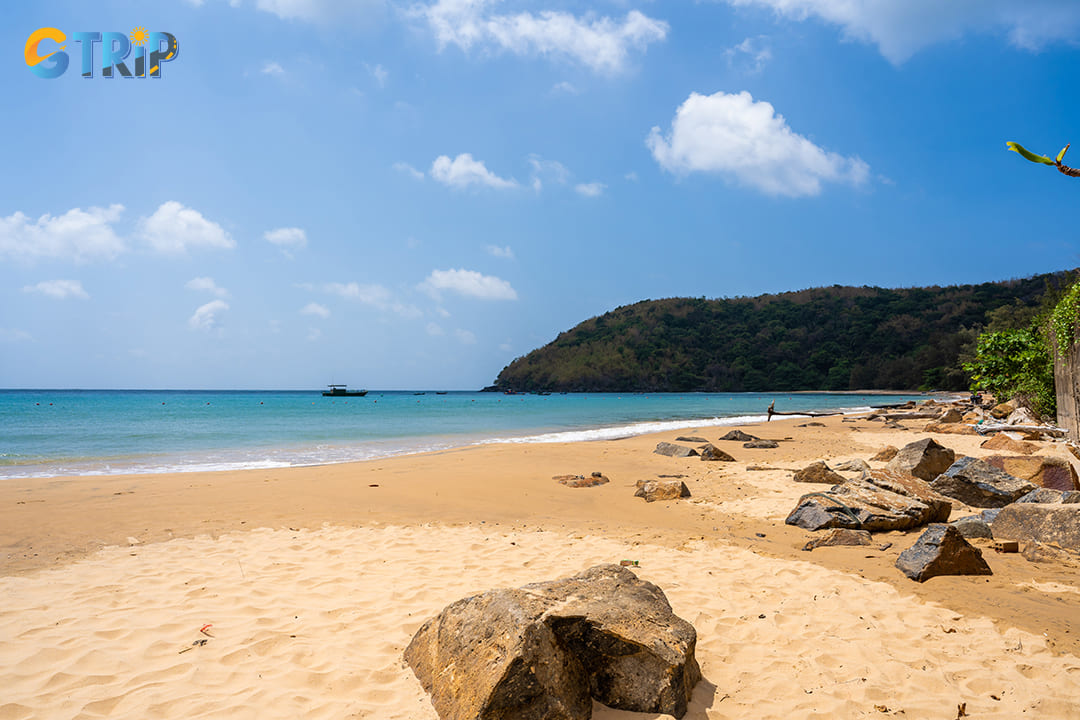
The beach is surrounded by lush green hills and features rocky formations that add to its natural charm
FAQs about Van Son Pagoda
1. Can I take photos inside the pagoda?
Photography is generally permitted in most areas of Van Son Pagoda, but you should be mindful of their surroundings. Inside prayer halls and sacred spaces, it is advisable to avoid using flash or taking photos during ceremonies, as it may disrupt worshippers. Certain areas, such as the Ancestor's Temple and Dia Tang Temple, may have restrictions, so it’s best to check with the temple staff before capturing images. Outside the main halls, you can take stunning photographs of the panoramic view overlooking Con Son Bay and An Hai lotus lake.
2. Can I bring food or drinks into the pagoda?
Bringing food or drinks into the prayer halls is generally discouraged as a sign of respect. However, you can carry bottled water, especially if you plan to hike up the steep steps leading to the pagoda. There are resting spots along the way where you can hydrate before continuing your journey.
3. Is Van Son Pagoda accessible for elderly tourists or those with mobility issues?
While the temple itself is open to all people, the climb up the 200+ stone steps can be challenging for elderly travelers or those with mobility concerns. There are handrails along the stairway to assist people, but no alternative transportation is available to reach the temple. Those who prefer a less physically demanding experience can explore Con Dao Museum, which offers deep insights into the island’s history and culture without the need for strenuous activity.
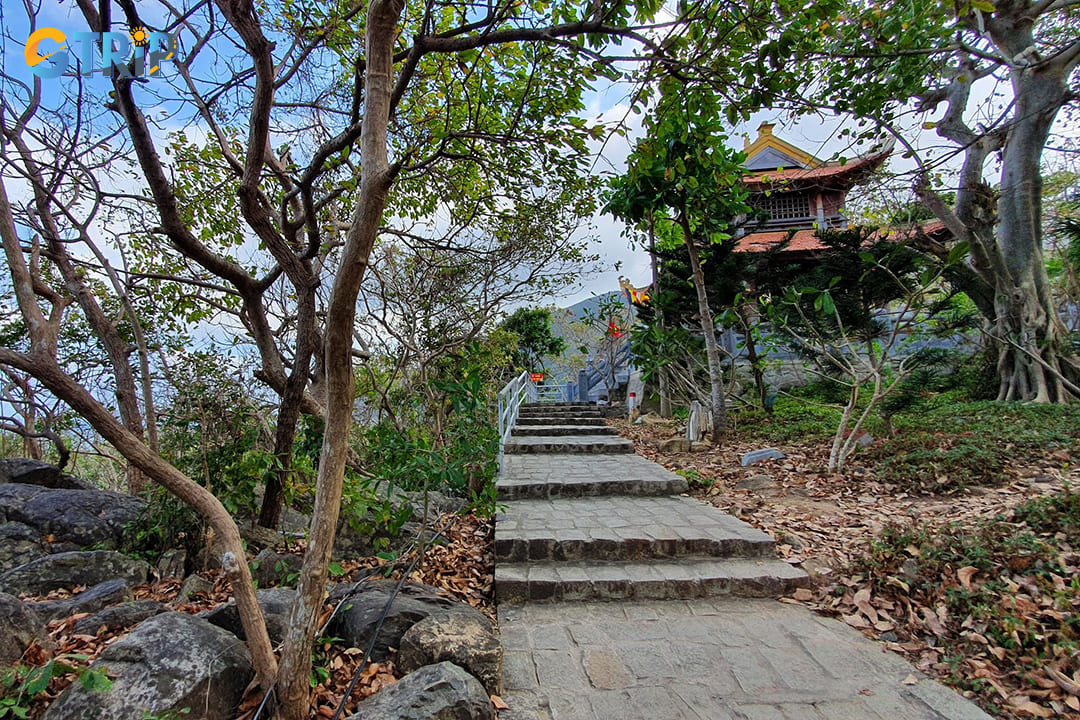
The climb up the 200+ stone steps can be challenging for elderly travelers or those with mobility concerns
Van Son Pagoda is more than just a place of worship, it is a destination that connects tourists to the deep-rooted history, intricate architecture, and serene landscapes of Con Dao. The journey to the temple, though requiring effort, rewards travelers with breathtaking scenic views and a profound spiritual experience. For those planning a trip, understanding the visitor guidelines, respecting the dress code, and choosing the best time to visit can enhance the experience. With its rich history, stunning landscapes, and deep spiritual heritage, this island promises an unforgettable journey. Let GTrip - Vietnam Travel Agency help you explore the best of Vietnam with expert guidance and tailored experiences.

